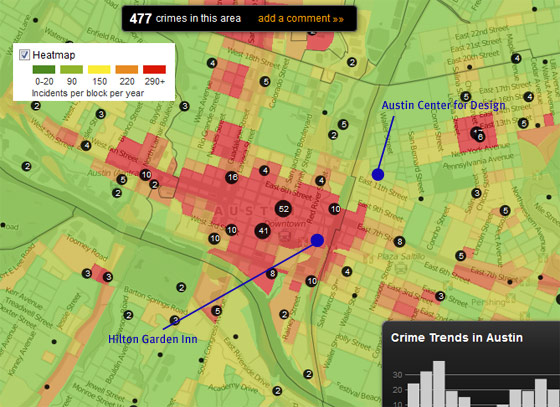This is from 2012 | 4 minute read
It's Not Safe on the East Side: Perceptions of Fear
I met yesterday with a researcher who studies homeless teenagers; she happened to be in town for the CHI conference. She was staying at a hotel about a quarter mile from Austin Center for Design, the Hilton Garden Inn. When she asked the concierge for directions, he told her not to walk, because "it's not safe on the east side." He drove her a quarter mile in a Suburban.
Never mind that it was in broad daylight, that the walk was literally a quarter of a mile away, that the researcher spends her career embedded in "dangerous areas", or that the hotel was in a more crime-rich area than our school. The concierge, like most of Austin, has an image of the East Side as a scary, dangerous place that isn't safe.

Here are Austin's crime figures (per 100,000 people):
| Population | 796,310 |
|---|---|
| Violent Crime | 475.9 |
| Murder | 4.8 |
| Forcible rape | 33.3 |
| Robbery | 154.6 |
| Aggravated assault | 283.3 |
| Property crime | 5,754.8 |
| Burglary | 1,098.7 |
| Larceny-theft | 4,373.5 |
| Motor vehicle theft | 282.6 |
| Arson | 15.4 |
My reading of this is that, in Austin in 2010, for every 100,000 people, there were 476 violent crimes. That's about 3800 violent crimes for the entire city of 800,000. Assuming crime occurs evenly throughout the year and the time of day (which it clearly doesn't), the likelihood of a guest at the Hilton Garden Inn wandering over to the East Side and happening to be the one violent crime that occurs every 138 minutes in the entire city seems extraordinarily unlikely.
*
What does it mean for a place to "not be safe"? Does it mean that the people that live there are perpetually in danger? Does it mean that there's more likelihood of something bad happening to you if you go there? Does it mean that the police don't do as good as job in that area, or that crime is naturally drawn to and established in that area?
It might be the physical infrastructure of a place makes people feel safe. Some research in 1984 into public parks found that "high security is associated with open areas with long view distances and with signs of development and nearby populated areas. On the other hand, high scenic qualities depends on the presence of natural vegetation, in either forests or park-like settings, and is lowered by manmade features."
Or, it might be that the travelers level of knowledge affects how they feel regarding safety. Research from Thomas Pinhey and Thomas Iverson indicates that tourists who are informed about a region in which they are traveling feel safer.
Other research indicates that "For whites the analysis suggests that fear is affected by property crime rates and the proportion of crime which is interracial, and that racial composition indirectly affects fear by strongly influencing the proportion of crime which is interracial." (link)
It seems like it's all of these things and none of these things at once. I actually think that our assumptions about personal safety are as flawed as our assumptions about how the rest of the systems in our culture work or should work. We build up a shallow frame around what we think we understand, be it democracy, technology, or violent crime, and then that frame is continually reinforced by additional assumptions about how life should be. When those of us from middle class suburbs visit East Austin, or to any other "poor" area, we see things that conflict with our upbringing. This is emotionally difficult to rationalize. It's unpredictable. It creates a sense of "us" and "them", because it's challenging to relate to strange living conditions. The assumptions at play when talking about avoiding the East Side of Austin seem to include "My life should be free of conflict", "When I'm in an emotionally uncomfortable situation, I'm in danger", and "Experiences that are unpredictable are not desired." These are the same assumptions my students have had to overcome in talking with and engaging with the poor or the homeless.
Most teachers know that, for students to really learn, they need to be outside of their "comfort zone"—they need to experience things that are conflicting, emotionally uncomfortable, and unpredictable. East Austin is beautiful. It's not scary. There are areas that are poor, and there are areas that aren't. Your city is likely similar. Talking to homeless people isn't scary. Seeing other cultures isn't scary. All of these things are conflicting, emotionally uncomfortable, and unpredictable. But they aren't scary.
Stop living in fear.
Originally posted on Tue, 08 May 2012